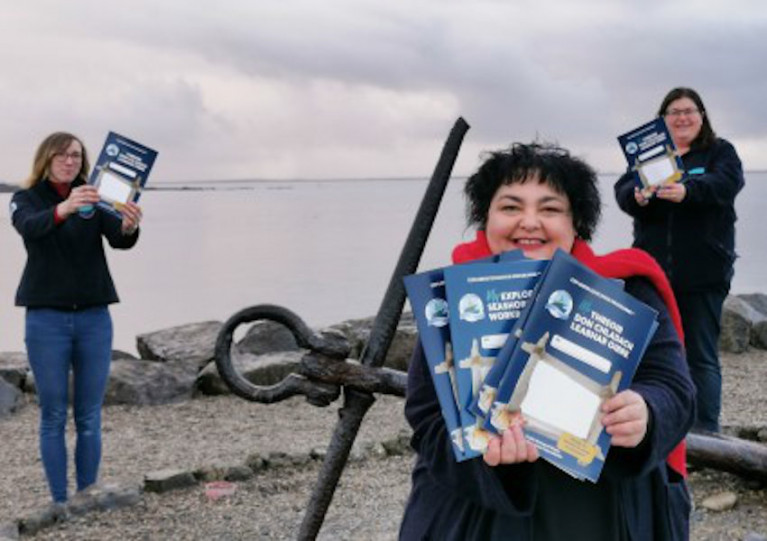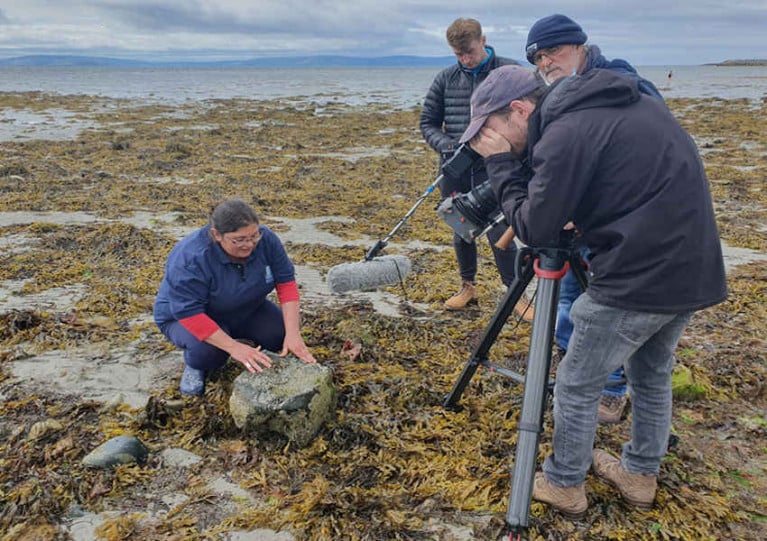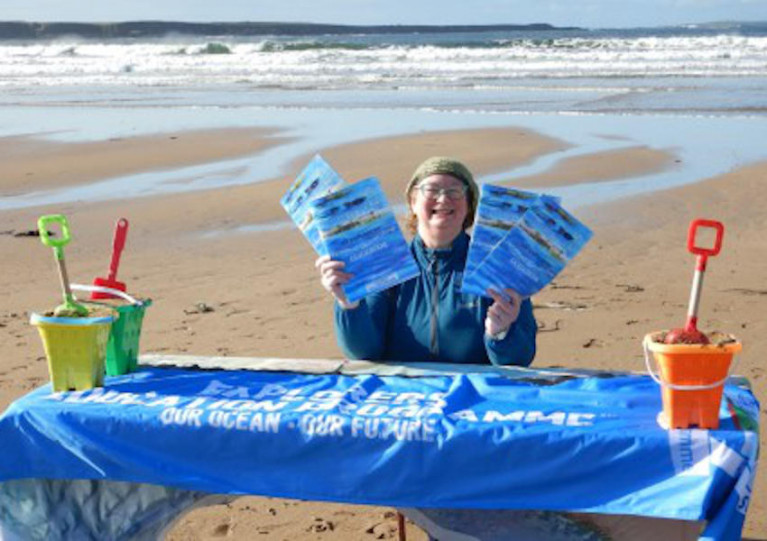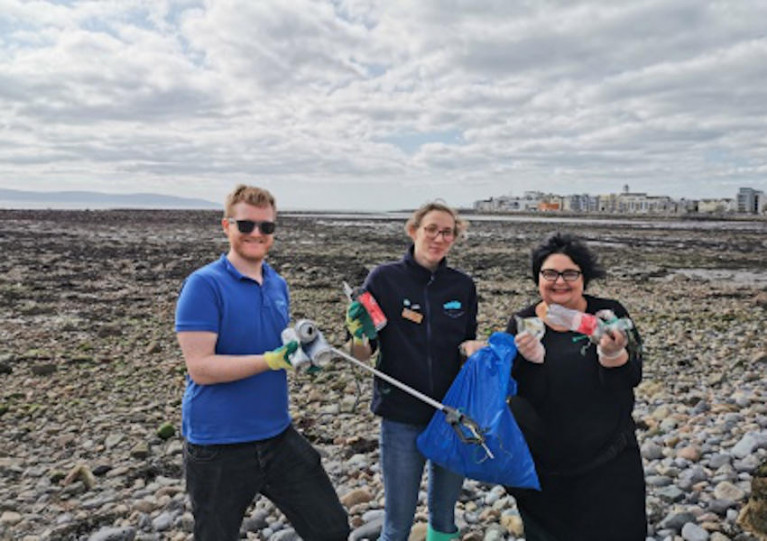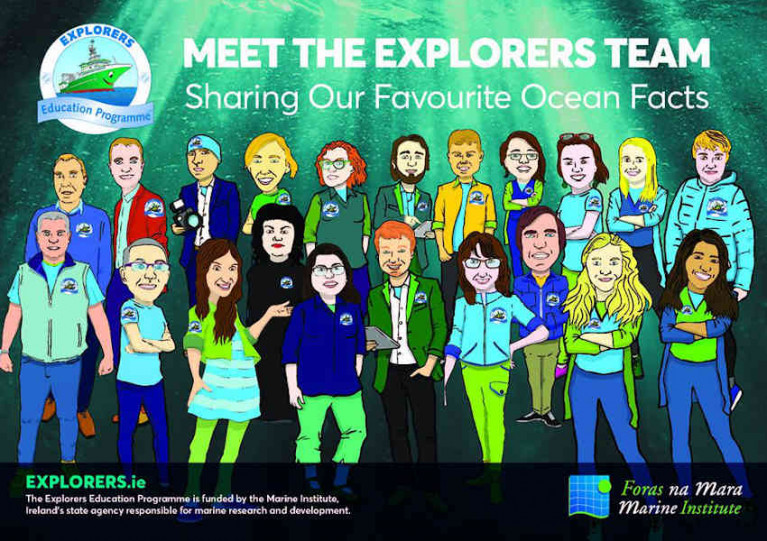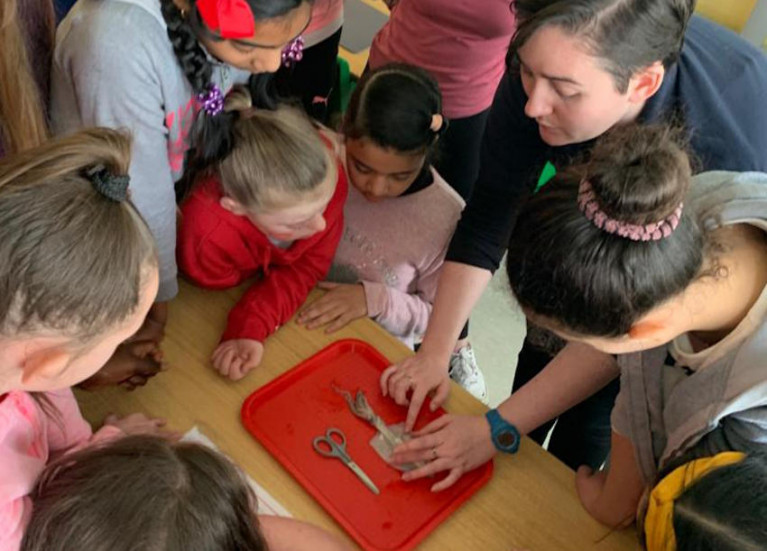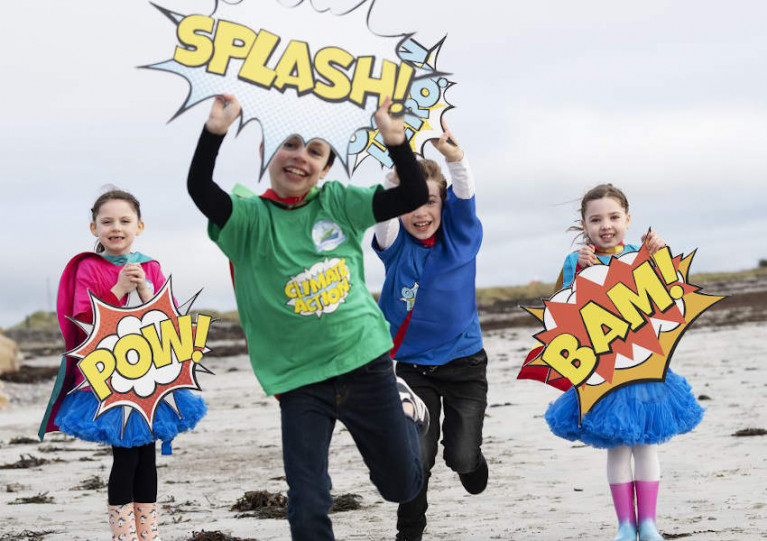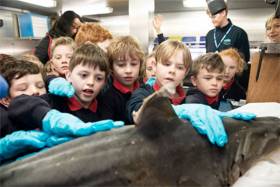Displaying items by tag: Explorers Education Programme
Explorers Education Programme’s Workbook Causes a ‘CommOCEAN’ at International Conference
A publication by the Marine Institute’s Explorers Education Programme that connects children, parents, teachers and the media with the seashore in Ireland has been highlighted at a major international conference.
My Explorers Seashore Guide Workbook was recently presented at the 4th International Marine Science Communication Conference, CommOCEAN, which brings marine science experts and communication professionals together to learn more about advocating the spread and outreach and communication about the ocean.
Speaking at the conference, the book’s author Cushla Dromgool-Regan said: “To really engage and be passionate about caring for our marine environment, it is said that we need to be able to see it, hear it, feel it, smell it and taste it.
“Therefore, with over half of Ireland's population living 5km from the coast in Ireland, the seashore is the perfect playground to learn about our ocean.
“The Explorers workbook can be used to help inspire learning about the shore before, during and after heading to the beach. It can be used by children of all ages to learn about the amazing animals, seaweeds and habitats that can be found our doorstep.”
My Explorers Seashore Guide Workbook was launched earlier this year to mark International Biodiversity Day, as previously reported on Afloat.ie, and more than 800 copies of the book were downloaded within its first couple of months.
“I am delighted that the book sparked a keen interest with teachers and parents teaching at home this year, as well as the media’s interest in sharing our stories and passion for the sea,” added Dromgood-Regan, who is also Explorers strategic manager and communication lead from the Camden Education Trust.
“The importance of learning, communicating and engaging in decisions about our ocean, starts at home around our kitchen table.”
As announced at CommOCEAN, the My Explorers Seashore Guide Workbook is now published in English and Irish as a free download from the Marine Institute’s open access library.
Step Aboard the Celtic Explorer & More at Galway Science & Technology Virtual Festival
The Marine Institute and its Explorers Education Programme will once again be a part of the Galway Science and Technology Festival, which this year is a virtual experience for families on the weekend of 21-22 November.
Step aboard the Marine Institute’s marine science research vessel Celtic Explorer via a 90-minute livestream on Sunday 22 November from 11am to learn about some of its unique features, and why it is so important for fisheries research, climate studies and seabed mapping.
After the virtual show, jump aboard the RV Celtic Explorer and take a 3D virtual tour, or enjoy downloadable resources, videos and interactive activities that explore Ireland’s marine resource from the Oceans of Learning series.
And the weekend starts off with a trip to the seashore with the Explorers Education Programme team, who get ‘Wild about Wildlife’ as part of a special video series that’s been screened for schools this week as part of Science Week. Tune into the Galway Science & Technology Festival’s YouTube channel at 11am on Saturday 21 November (and again at 3pm on Sunday 22).
Marine Institute chief executive Dr Paul Connolly said: “The Marine Institute has supported the annual Galway Science and Technology Festival for many years, and is delighted to engage with parents and children through an online platform this year.
“The annual outreach event nurtures students’ interest and curiosity in science and technology subjects, and is also an opportunity for the Marine Institute, and our Explorers Education Programme, to raise awareness about the importance of our ocean and the work of our scientists.”
Meanwhile, the institute is also encouraging children to get creative and colour in a picture of the RV Celtic Explorer.
The winning entry will receive a LEGO City Ocean Exploration Submarine Deep Sea Set, and there are also two LEGO City Ocean Exploration Mini-Submarine Sets on offer.
To enter, download a copy of the colouring competition from the Marine Institute’s website, post a photo of your finished creation to social media and tag the institute on Twitter or Facebook. Winners will be announced on Friday 27 November.
Get Wild About Wildlife with the Explorers Education Team for Science Week
The Marine Institute’s Explorers Education Programme is interacting with children around Ireland among events for Science Week, which continues to this weekend.
Exploring the seashore will be the focus of the Explorers team as they share their Wild About Wildlife on the Seashore film and host Q&As with primary school pupils tomorrow, Wednesday 11 November.
Join them as they go on a journey to one of the most extreme places on earth where animals live. Find out about the seashells and their friends, including some of the tiniest periwinkles to top shells with the coolest spirals, feasting on seaweed.
Then head to the lower shore to help the team hunt down the carnivorous dog whelk — the shellfish which loves to make limpets into soup!
See the websites for the Cork Science Festival, Kerry Science Festival, Midlands Science, Galway Science & Technology Festival and the South-East Science Festival for more, and browse the full list of events on the SFI website.
Fifth and sixth class pupils at St Patrick’s National School in Craanford, Co Wexford had the opportunity to share their knowledge of sharks with RTÉ’s children’s news programme news2day this afternoon (Wednesday 4 November).
The youngsters recently took part in a project on the fearsome fish with the Marine Institute’s Explorers Education Programme, learning more about the sharks found in Irish waters and around the world.
Explorers outreach officer Padraic Creedon worked with teacher Jackie Cousins and her class as they were inspired by stories such as the discovery of a rare shark nursery 200 miles off the west coast of Ireland.
“Working with the Wexford class from my Galway base has been one of my highlights this year,” Creedon said.
“Seeing their work, from the shark frame on their classroom door to the detailed sculptures and art work of various Irish sharks created by the students, was fantastic.
“The children’s work showing the basking shark, which is found in Irish waters and the second largest shark in the world, was a particular favourite of mine.
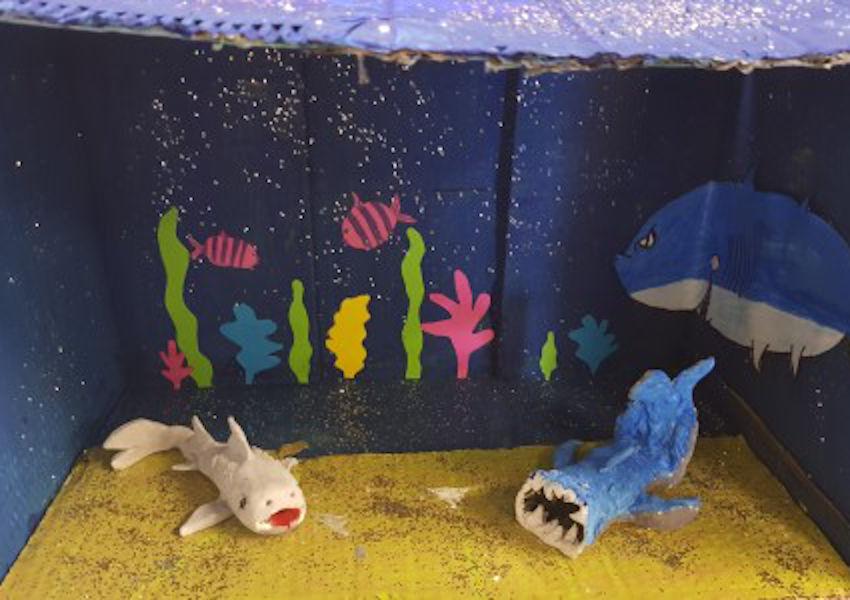 Shark diorama by pupils at St Patrick’s NS | Photo: Padraic Creedon
Shark diorama by pupils at St Patrick’s NS | Photo: Padraic Creedon
“This all highlighted the importance of engaging in ocean exploration and creating ocean champions at primary school level,” added Creedon, who also works at Galway Atlantaquaria.
“Connecting with the children on line and in the class with Padraic generated huge excitement for us all,” said their teacher Jackie Cousins. “The children's enthusiasm to learn about sharks helped us incorporate a range of subjects in the class from science and English to the arts.
“The Explorers approach with the class also gave the children a voice, where they were able to lead the discussion about sharks and what they wanted to learn.
“This sense of collective engagement as well as doing their own research opened up an amazing sense of discovery, where they have excelled and produced some incredible work, from writing facts and stories about sharks to producing a series of posters and artwork.”
Mícheál Ó Scannáil, the news2day presenter who interviewed the class in his home county, was also struck by the children’s enthusiasm for sharks and their ocean habitat.
“We had great fun in Craanford and the kids and Padraic taught me a lot about sharks. I still don't know if I’d hop in the sea with them, though!”
The segment featuring the pupils of St Patricks’s NS begins at 2m40s into today’s edition of news2day on the RTÉ website HERE.
Explorers Education Team is Creating ‘Ocean Champions’ in Co Clare
Creating ‘ocean champions’ around Ireland is the latest mission for outreach team members from the Marine Institute’s Explorers Education Programme.
The team are delivering a range of marine projects and seashore safaris in primary schools through blended learning, online activities and outdoor class visits.
This has involved adapting their favourite marine projects and developing new content for teachers and primary school children to use in the classroom.
Each month the programme will launch a new project and a series of new resources teachers and pupils can use. This month’s project is ‘An Ocean of Stories — My Explorers Personal Story’, created by Co Clare-based Explorers outreach officer Carmel Madigan.
The artist, author and habitat researcher says her creative writing project “focuses on wellbeing, creativity and reflecting on our connection with the ocean”.
She adds: “This is a great time to reflect and use our imagination and share our stories. These might include the day the sand got into my sandwiches to the drama of picking up a large seashore crab.
“We will be celebrating the children's work by sharing the stories on the Explorers social media pages. We will also be publishing a selection of our favourite submissions in an Anthology of Short Ocean Stories next year on World Oceans Day.”
Schools and students lacking in broadband access won’t be left out, either, as Carmel has produced a series of videos to inspire the children with their work with will be sent to teachers to share with their classes.
“We have really worked outside the box this term and the Explorer teams have done an amazing job coming up with projects that classes and schools can still take part in,” said the programme’s strategic education manager, Cushla Dromgool-Regan of the Camden Education Trust.
“This includes online engagement, personalised film messages and traditional letter-writing, to name a few. A huge volume of support materials have also been created for the teachers to use in class with the children including interactive short films, workbooks, fun facts and posters.”
Explorers weekly updates are posted on Facebook and Twitter. If you are interested in your class taking part in an Explorers project, contact your nearest Explorers outreach officer or the support services team at Galway Atlantaquaria for more via www.explorers.ie
Galway Explorers Team Hits The Beach For ‘World Cleanup Day’
The Marine Institute’s Explorers Education Programme team has joined marine scientists, teachers and educators across Europe and North America to hit the beach to celebrate World Cleanup Day, which took place this year last Saturday 19 September.
During the month of September, members of the EMSEA-Atlanic network from Ireland, Azores, Portugal, USA and Canada have been taking part in local beach cleanups “with a focus on highlighting some of the prominent litter items frequently found on our seashores around the Atlantic”, according to EMSEA board member Evy Copejans.
As well as bringing communities together to learn more about marine wildlife and the marine environment, beach cleanups are also opportunity to find the most extraordinary things washed up on the shore.
In the past, EMSEA members have found messages in bottles, rubber ducks, bowling balls, and mini-boats that have drifted on currents across the Atlantic.
And they are sharing any oddities and treasures discovered on beaches on social media with the hashtags #seawhatifound and #EMSEAAtlantic.
“On the west coast of Ireland, in Galway we often find buoys, fishing gear and sometimes items from halfway across the world,” said Padraic Creedon, outreach officer at Galway Atlantaquaria.
Explorers’ Cushla Dromgool-Regan added: “We are connected by the ocean in so many ways and recognise the importance of working together to ensure the ocean is sustained for our families, friends and future generations.
“Coastal clean-ups help us raise awareness about the connections we have and the influence the ocean has on us, as well as the impact we have on the ocean.”
The Marine Institute’s Explorers Education Programme outreach team are currently sharing their favourite marine facts and lesson plans about the ocean for teachers, parents and primary school children to use while learning from home.
The ‘Meet the Explorers Team’ online initiative is in recognition of International Earth Day, celebrated each year from the beginning of spring to Earth Day itself on 22 April, says Explorers Education manager Cushla Dromgool-Regan.
“Many of our Explorers outreach teams are going digital this month sharing their stories, favourite facts and providing free lesson plans to help raise awareness about the ocean and all the life it supports,” she added.
The Explorers team will be posting ocean facts on its Facebook and Twitter social media channels, and have set up a dedicated web page for teachers and parents to download free lesson plans, activities, project ideas and fun facts about the ocean over the coming weeks.
They are also keen to share children’s favourite facts, stories and projects about the ocean online. Keep an eye on social media for updates, competitions and sharing new stories about the ocean.
Explorers Education Programme Is Loving The Ocean On Valentine’s Day
Global Action Plan Ireland and the Irish National Sailing & Powerboat School (INSS) shared their love for the ocean on Valentine’s Day with primary schools in Ballymun and Dun Laoghaire as part of the Marine Institute’s Explorers Education Programme.
With a Master’s degree in Marine Sustainability and a passion for sharing her love for the ocean, Eimear Manning, education officer with Global Action Plan Ireland, started an Explorers marine science project with over 25 children from Virgin Mary GNS in Ballymun, North Dublin.
Beginning this week, they will be exploring everything from plankton to sharks, and how climate change effects all creatures in the sea. Sharks are a speciality of Eimear’s, who joins frequent expeditions in Florida to tag and collect data on sharks off the Miami coast.
“I am really excited to be involved in the Explorers Education Programme and having their support providing clear objectives of how to increase marine engagement and ocean literacy in schools in Ireland,” she said.
“Having also recently represented Ireland at the All-Atlantic Ocean Research Forum in Brussels as an All-Atlantic Youth Ambassador has highlighted the importance of children engaging in our ocean.
“The involvement of youth in addressing how we enjoy and use our ocean resources helps to ensure we are better equipped to look after our environment now and into the future.”
Also involved in the pilot outreach training is Muriel Rumball from INSS, who brings a wealth of expertise to the team where she has been involved in teaching children about all aspects of the ocean, from marine recreation to formal education.
Running a seashore safari with students from Glenageary Killiney National School, Muriel highlighted the value of teaching children about the marine on the curriculum.
“I have worked with children for many years both in and out of school and it is extremely important that we give children the opportunity to extend their education relating to environmental care outdoors,” she said.
‘Exploring the seashore at our doorstep is key to ensuring we learn to truly value, love and engage with the ocean in a positive way’
“Sharing and seeing children touch, feel and smell the ocean as well as exploring the seashore at our doorstep is key to ensuring we learn to truly value, love and engage with the ocean in a positive way.”
Recently selected to take part in Explorers pilot training, the teams — along with four other outreach centres from Louth, Wexford and Limerick — took part in a three-day workshop in Galway run by Dr Noirin Burke of Galway Atlantaquaria and Cushla Dromgool-Regan of the Camden Education Trust.
“The training programme provided an excellent introduction for outreach centres wanting to learn more about how to introduce concepts of ocean literacy onto the curriculum, as well as support key aspects of the UN Sustainable Development Goals, with a particular reference to climate action and the ocean,” said Cushla, who is responsible for the strategic development and management of the Explorers Education Programme.
Welcoming the opportunity to support new centres and expand the Explorers reach around the country, Dr Burke added: “Initiatives like this help build on the success of the Explorers programme who have been working with primary schools for over fourteen years.
“We are delighted to be able to share our knowledge with the centres as well as help develop a stronger network of marine outreach professionals throughout Ireland.”
Dr Paul Connolly, chief executive of the Marine Institute, congratulated the Explorers training team and the centres in taking part in the pilot outreach training programme.
“Developing marine outreach that can support teachers in classrooms is key to ensuring children receive a unique experience of learning and engaging with the ocean,” he said. “In turn, this helps to equip children in becoming ocean leaders and marine champions of the future.”
For more information about the Explorers Education Programme see www.explorers.ie
Primary school children across Ireland are being invited to use the power of their imagination to save the ocean from climate change in a new art and writing competition.
The Explorers Pop Art & Creative Writing Competition was launched earlier this week by the Marine Institute’s Explorers Education Programme.
“By bringing science, art and creative writing together, the aim of the ‘ocean superhero’ competition is to cultivate the children's imagination, creating new ideas and solutions when addressing issues of environmental care and climate change,” said Cushla Dromgool-Regan, Explorers Education manager from Camden Education Trust who is co-ordinating the contest.
“The idea of creating an ocean superhero aims to help create a sense of hope for children at a time of adversity in the world, when the impacts of climate change can seem extremely challenging.”
The winners will see their art work and stories showcased as part of the Marine Institute exhibit at SeaFest, Ireland’s largest maritime festival, from 14-17 May.
A shortlist of VIP winning classes will be invited to visit the Marine Institute’s research vessel and its exhibition at Seafest, where they will get to meet world-leading speakers and scientists who are all working towards Ireland’s challenge in responding and adapting to climate change.
The Explorers Education Programme website has more information about the competition, including details of how to enter.
Children from Rang 2 at Scoil Shéamais Naofa in Bearna got up close and personal with sharks on the RV Celtic Explorer as part of the Marine Institute’s outreach and engagement programme.
The pupils completed a project module on sharks in Irish waters as part of the Marine Institute’s Explorers Education Programme, and also had the opportunity to visit the State research vessel.
Outreach officer Padraic Creedon of the Explorers Education Programme said one if the programme’s unique elements “is the content and support provided to teachers in the classroom in an easy and fun way.
“The students were inspired by the discovery of a rare shark nursery 200 miles off the west coast of Ireland in 2018, and we were delighted to create lessons, interactive experiments and discussion about the ocean, sharks and their environment for the class.”
While on board the RV Celtic Explorer, pupils met with the captain and scientists and saw what it might be like to work on a research vessel.
Students spoke with Captain Denis Ronan about the Celtic Explorer, and learn more about the acoustically silent ship that can stay out at sea for up to 35 days.
The pupils were excited to tour the vessel and speak with marine scientists to discover more about shark species, seabed mapping, shipwrecks and the marine environment.
Visiting the dry and wet labs, the pupils saw various fish species from recent surveys and shark species, such as dogfish and the tope shark.
Clár Ní Bhraonáin, teacher at Scoil Shéamais Naofa, said: “It has been an amazing experience … Students don’t forget days like this.”
The Explorers programme offers a range of materials including lesson plans to conduct experiments in class, watching films that helps generate discussion, and peer learning among pupils.
“Because of the students’ enthusiasm to learn more about sharks, we have been able to incorporate marine themes across the curriculum, where they have excelled and produced some incredible work, from writing books about sharks to a series of posters and artwork,” Ní Bhraonáin added.
“This project has really helped myself and the students learn more about the ocean.”
For more information on the Explorers Education outreach centres, visit the Explorers Contacts page at Explorers.ie. The programme is supported by the Marine Institute and is funded under the Marine Research Programme by the Government.





























